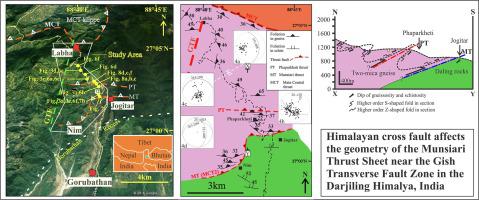当前位置:
X-MOL 学术
›
J. Asian Earth Sci.
›
论文详情
Our official English website, www.x-mol.net, welcomes your
feedback! (Note: you will need to create a separate account there.)
Himalayan cross faults affect thrust sheet geometry: an example from the Munsiari thrust sheet near the Gish Transverse fault zone, frontal Darjiling Himalaya, India
Journal of Asian Earth Sciences ( IF 2.7 ) Pub Date : 2020-09-01 , DOI: 10.1016/j.jseaes.2020.104400 Abdul Matin , Malay Mukul
Journal of Asian Earth Sciences ( IF 2.7 ) Pub Date : 2020-09-01 , DOI: 10.1016/j.jseaes.2020.104400 Abdul Matin , Malay Mukul

|
Abstract The Munsiari thrust (MT) sheet is a dominant thrust sheet in the Himalaya and forms the frontal ridge in the Gorubathan recess of the Darjiling Himalaya. The geometry of the MT sheet in the recess was poorly constrained thereby inhibiting the understanding of how the geometry and kinematics of the sheet varied from the Nepal to the Bhutan Himalaya. We present new structural data and infer the deformation mechanisms and the geometry of the MT sheet in the Gorubathan recess in the Darjiling Himalaya to fill this knowledge gap. The MT sheet was dominated by large-scale, overturned antiforms and synforms. The entire MT sheet was later folded to a north-easterly plunging synformal fold with NE-SW axial trend due to the effect of a Himalayan cross fault in the region named the Gish Transverse fault. A new brittle, out-of-sequence and neotectonically active, Phaparkheti thrust, was recognized in the MT sheet. Deformation microstructures indicate that the temperature of deformation in the MT fault zone and the sheet was ~500 °C to 700 °C and ~400 °C, respectively. Our approach of first mapping major and minor structures and then integrating these studies with deformation microstructure and tectonic geomorphology data resulted in an improved understanding of the structural characteristics of the MT sheet in the Darjiling Himalaya. Our study also suggests that there is considerable variation in the geometry and kinematics of frontal thrust sheets along the Himalayan arc that must be studied systematically in the context of Himalayan salients and recesses.
中文翻译:

喜马拉雅交叉断层影响冲断层几何形状:以印度大吉岭喜马拉雅前缘 Gish 横向断层带附近的 Munsiari 冲断层为例
摘要 Munsiari逆冲断层(MT)是喜马拉雅山主要的逆冲断层,形成了大吉岭喜马拉雅山Gorubathan凹陷的锋脊。凹槽中 MT 片材的几何形状受到不良约束,从而抑制了对从尼泊尔到不丹喜马拉雅山的片材几何形状和运动学变化的理解。我们提供了新的结构数据,并推断出大吉岭喜马拉雅山 Gorubathan 凹陷中 MT 板的变形机制和几何形状,以填补这一知识空白。MT 表主要是大规模的、翻转的反形式和同形式。由于喜马拉雅横向断层在名为 Gish 横向断层的地区的影响,整个 MT 片层后来被折叠成东北向同形褶皱,具有 NE-SW 轴向趋势。一个新的脆,在 MT 表中发现了失序和新构造活动的 Phaparkheti 逆冲断层。变形微观结构表明MT断层带和板材的变形温度分别为~500°C至700°C和~400°C。我们首先绘制主要和次要结构,然后将这些研究与变形微观结构和构造地貌数据相结合的方法导致对大吉岭喜马拉雅山 MT 片结构特征的更好理解。我们的研究还表明,沿喜马拉雅山弧的锋面逆冲片的几何形状和运动学存在相当大的变化,必须在喜马拉雅山的凸起和凹陷的背景下进行系统研究。变形微观结构表明MT断层带和板材的变形温度分别为~500°C至700°C和~400°C。我们首先绘制主要和次要结构,然后将这些研究与变形微观结构和构造地貌数据相结合的方法导致对大吉岭喜马拉雅山 MT 片结构特征的更好理解。我们的研究还表明,沿喜马拉雅山弧的锋面逆冲片的几何形状和运动学存在相当大的变化,必须在喜马拉雅山的凸起和凹陷的背景下进行系统研究。变形微观结构表明MT断层带和板材的变形温度分别为~500°C至700°C和~400°C。我们首先绘制主要和次要结构,然后将这些研究与变形微观结构和构造地貌数据相结合的方法导致对大吉岭喜马拉雅山 MT 片结构特征的更好理解。我们的研究还表明,沿喜马拉雅山弧的锋面逆冲片的几何形状和运动学存在相当大的变化,必须在喜马拉雅山的凸起和凹陷的背景下进行系统研究。我们首先绘制主要和次要结构,然后将这些研究与变形微观结构和构造地貌数据相结合的方法导致对大吉岭喜马拉雅山 MT 片结构特征的更好理解。我们的研究还表明,沿喜马拉雅山弧的锋面逆冲片的几何形状和运动学存在相当大的变化,必须在喜马拉雅山的凸起和凹陷的背景下进行系统研究。我们首先绘制主要和次要结构,然后将这些研究与变形微观结构和构造地貌数据相结合的方法导致对大吉岭喜马拉雅山 MT 片结构特征的更好理解。我们的研究还表明,沿喜马拉雅山弧的锋面逆冲片的几何形状和运动学存在相当大的变化,必须在喜马拉雅山的凸起和凹陷的背景下进行系统研究。
更新日期:2020-09-01
中文翻译:

喜马拉雅交叉断层影响冲断层几何形状:以印度大吉岭喜马拉雅前缘 Gish 横向断层带附近的 Munsiari 冲断层为例
摘要 Munsiari逆冲断层(MT)是喜马拉雅山主要的逆冲断层,形成了大吉岭喜马拉雅山Gorubathan凹陷的锋脊。凹槽中 MT 片材的几何形状受到不良约束,从而抑制了对从尼泊尔到不丹喜马拉雅山的片材几何形状和运动学变化的理解。我们提供了新的结构数据,并推断出大吉岭喜马拉雅山 Gorubathan 凹陷中 MT 板的变形机制和几何形状,以填补这一知识空白。MT 表主要是大规模的、翻转的反形式和同形式。由于喜马拉雅横向断层在名为 Gish 横向断层的地区的影响,整个 MT 片层后来被折叠成东北向同形褶皱,具有 NE-SW 轴向趋势。一个新的脆,在 MT 表中发现了失序和新构造活动的 Phaparkheti 逆冲断层。变形微观结构表明MT断层带和板材的变形温度分别为~500°C至700°C和~400°C。我们首先绘制主要和次要结构,然后将这些研究与变形微观结构和构造地貌数据相结合的方法导致对大吉岭喜马拉雅山 MT 片结构特征的更好理解。我们的研究还表明,沿喜马拉雅山弧的锋面逆冲片的几何形状和运动学存在相当大的变化,必须在喜马拉雅山的凸起和凹陷的背景下进行系统研究。变形微观结构表明MT断层带和板材的变形温度分别为~500°C至700°C和~400°C。我们首先绘制主要和次要结构,然后将这些研究与变形微观结构和构造地貌数据相结合的方法导致对大吉岭喜马拉雅山 MT 片结构特征的更好理解。我们的研究还表明,沿喜马拉雅山弧的锋面逆冲片的几何形状和运动学存在相当大的变化,必须在喜马拉雅山的凸起和凹陷的背景下进行系统研究。变形微观结构表明MT断层带和板材的变形温度分别为~500°C至700°C和~400°C。我们首先绘制主要和次要结构,然后将这些研究与变形微观结构和构造地貌数据相结合的方法导致对大吉岭喜马拉雅山 MT 片结构特征的更好理解。我们的研究还表明,沿喜马拉雅山弧的锋面逆冲片的几何形状和运动学存在相当大的变化,必须在喜马拉雅山的凸起和凹陷的背景下进行系统研究。我们首先绘制主要和次要结构,然后将这些研究与变形微观结构和构造地貌数据相结合的方法导致对大吉岭喜马拉雅山 MT 片结构特征的更好理解。我们的研究还表明,沿喜马拉雅山弧的锋面逆冲片的几何形状和运动学存在相当大的变化,必须在喜马拉雅山的凸起和凹陷的背景下进行系统研究。我们首先绘制主要和次要结构,然后将这些研究与变形微观结构和构造地貌数据相结合的方法导致对大吉岭喜马拉雅山 MT 片结构特征的更好理解。我们的研究还表明,沿喜马拉雅山弧的锋面逆冲片的几何形状和运动学存在相当大的变化,必须在喜马拉雅山的凸起和凹陷的背景下进行系统研究。











































 京公网安备 11010802027423号
京公网安备 11010802027423号